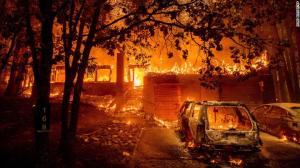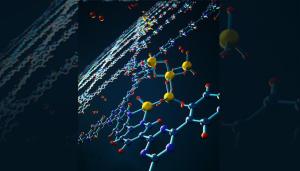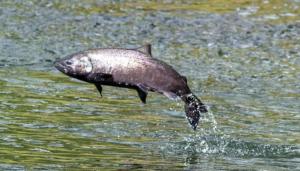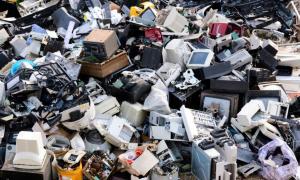LAB REPORT
Science and Technology Making Headlines
Nov. 5, 2021

Flames consume a home as the Dixie Fire (California’s largest wildfire) tears through the Indian Falls community in Plumas County.
Humans drive wildfires
In a finding that scientists believed was still decades away from becoming reality, California researchers say that humans are now the overwhelming cause of conditions driving extreme wildfire behavior in the western United States.
As world leaders gathered in Scotland this week to discuss plans to reduce greenhouse gas emissions, a study released this week said that global warming was essentially two-thirds to 88 percent responsible for the atmospheric conditions fueling increasingly destructive wildfires.
And that’s a conservative estimate, according to researchers at Lawrence Livermore and UCLA.
“If mitigation efforts aren’t taken, wildfire activity in the western United States will increase, resulting in significant impact on human lives, human health and the economy,” said climate scientist Benjamin Santer, who recently retired from LLNL and is now at UCLA.


View of a subnanoscale reversible alane cluster coordinated to a bipyridine site on covalent triazine-based framework that can be used in hydrogen storage systems.
New hydrogen storage material steps on the gas
Lawrence Livermore and Sandia researchers are looking at ways to improve the way aluminum hydride is used for hydrogen storage.
Aluminum hydride (AlH3), a solid-state metal hydride, which is also known as “alane,” is commonly used for rocket fuel, explosives, as a reducing agent in alkali batteries and as a hydrogen source for low-temperature fuel cells.
According to the researchers, this material is able to overcome the challenge represented by the thermodynamic limitation of hydrides in storing hydrogen.
“Many high-capacity metal hydrides suffer from poor thermodynamics of hydrogen uptake after initial release, which necessitates extreme hydrogen pressures to regenerate,” the scientists explained. “Such a limitation is often tied to their metastable nature and hinders their real-world applications.”


A returning adult spring-run Chinook salmon leaps from the water in California’s Central Valley. Photo courtesy of Carson Jeffres/UC Davis.
Relying on an uncommon life history
Southern salmon populations face increased risk from a warming climate. New analysis of salmon ear bones, from researchers from NOAA Fisheries’ Southwest Fisheries Science Center, Lawrence Livermore and collaborators, shows outsized reliance on rarely used cold-water habitat for population survival through drought years — habitat that is expected to shrink under climate change.
The Pacific salmon has an iconic life history: hatching in inland streams, migrating long distances as juveniles to reach the ocean, growing there for years and then fighting back upstream as adults to spawn and die, their carcasses providing needed nutrients for their offspring and bears, eagles and even inland forests.
Within this basic pattern is considerable variability, especially in the timing of the juvenile and adult migrations. In the new research, scientists used innovative techniques to relate the success of different migration timing strategies (that is, "life-history strategies") to the climate conditions during the juvenile migration years and find that the rarest migration strategy is the most important during dry and drought years, with implications for population survival under climate change.


LLNL engineers have developed a way of guaranteeing part quality produced by Liquid Metal Jet 3D printing.
In real time
Engineers at Lawrence Livermore have developed a way of optimizing the properties of any parts produced via Liquid Metal Jet (LMJ) 3D printing.
Instead of adopting a costly high-speed videography-based approach, the LLNL team has devised a means of combining near-field detection with simulation, to focus on just one parameter when analyzing jetted materials. Leveraging their methodology, the researchers say it’s possible to identify the causes of nozzle issues in real-time, before adjusting a printer’s settings to “guarantee part quality.”
“Our results demonstrate that in-situ monitoring of LMJ is possible with millimeter-wave detection methods,” said the study’s lead author Tammy Chang. “This is exciting because it means we could replace computationally expensive high-speed, high-resolution optical diagnostics to enable real-time performance evaluation and feedback control, to ensure high-quality printed metal parts.”


Rare earth metals are an essential component of mobile phones, computers and many other everyday devices.
It’s rare indeed
Penn State and Lawrence Livermore researchers have demonstrated an eco-friendly way to extract and separate rare earth elements (REEs) from unconventional sources. The method relies on a bacterial protein that is almost a billion times better at binding to REEs than to other metals. The protein, called lanmodulin, was previously discovered by the same research team.
According to the researchers, the new method could be scaled up to extract and separate REEs from low-grade sources, including industrial and electronic waste, to help establish a U.S. domestic supply of REEs.
In the all-aqueous method, lanmodulin is conjugated onto porous support materials to enable tandem REE purification and separation under flow-through conditions. The protein is immobilized onto tiny beads within a column, and the liquid source material is added. The protein binds to the REEs in the sample, which allows the REEs to be retained in the column while the remaining liquid is drained off.





